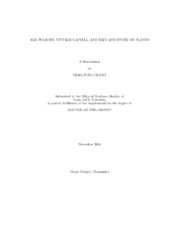| dc.description.abstract | Following Chamley, Lucas, Laitner, and Aiyagari, this dissertation continues to
explore the answer for the question of zero capital taxation by discussing how taxes
on capital income, labor income, and property affect the economy in the context
of a vintage capital model where the embodied technology grows exogenously. The
government maximizes social welfare by finding the optimal combinations of the three
tax rates in the steady state and examines the welfare gain/loss over and after the
transitions caused by different types of shocks. The simulation method used here is
linear approximation.
My results show that in the steady-state economy, given a fixed level of gov-
ernment expenditure and a zero property tax rate, the capital-income tax rate that
maximizes steady-state utility may be negative, zero, or positive depending on the
level of government expenditure. I also find that, for many values of government
spending, the highest level of steady-state utility occurs with a subsidy to capital
income and a tax on labor income. Finally, I find that when taxes on capital income,
labor income, and property are available, capital-income taxes are generally the last
resort to finance government expenditures.
My results show that in the transitional economy, when tax rates are perma-
nently changed and the government expenditure is near zero, the loss of utility over
the transition from no taxes to capital subsidies is too large so the idea itself is not
utility-enhancing. Secondly, I find that when the government expenditure is low and
a positive technology shock occurs, social welfare in the economy without capital-income taxes may perform better in the early phase of the transition but worse in the
later phase of the transition than that in the economy without property taxes. How-
ever, the situation becomes the opposite as government expenditures increase. In
addition, when one tax is allowed to change, a changing labor-income tax may bring
more utility over the transition than the other two taxes. Finally, when the govern-
ment expenditure is unexpectedly reduced, I find that using property taxes rather
than capital-income taxes stimulates consumption and employment more given a
higher initial level of government expenditure. | en |


